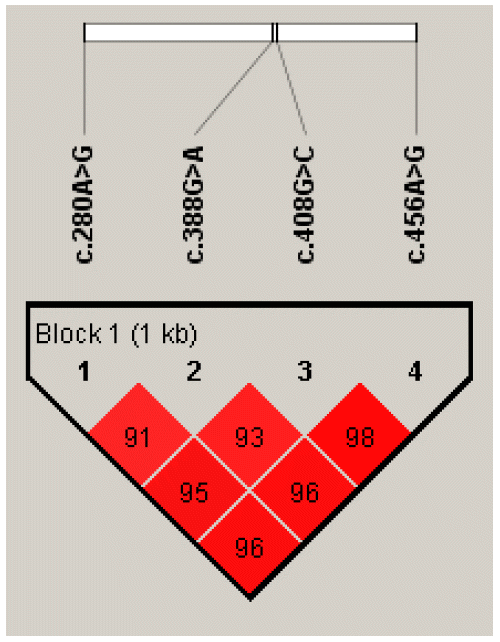 |
 |
Abstract
Table 1
Table 2
| SNP | Exon | Sequences | Product size | |
|---|---|---|---|---|
| c.181T>G | 2 | F1 | TTGACATTTTTCTTTTCCCAAC | 200 |
| R2 | TGACTTTCCTGTCATCTGGAG | |||
| E3 | CTGGCATGGCCAAACCCACT | |||
| c.193T>G | 2 | F | TTGACATTTTTCTTTTCCCAAC | 200 |
| R | TGACTTTCCTGTCATCTGGAG | |||
| E | AACCCACTTTGATCATCAGT | |||
| c.212C>A | 2 | F | TATAGGCGTGGGCTTTGCTA | 202 |
| R | GCTCCAGTTCTTTATTTCTCACC | |||
| E | TTTGAATGGGGGTGTGGTCA | |||
| c.280A>G | 2 | F | GGGGTGTGGTCACCATTAAA | 178 |
| R | TGGTTTGCTATAGGCAGCAG | |||
| E | TGGGCCAGGAATTTGATGAA | |||
| c.352T>G | 3 | F | CAAGGGCGATTGTCTATTTCTC | 208 |
| R | ATTATCCCCACAGAGCATCG | |||
| E | CTCTGGTACAAGTACAAAAC | |||
| c.364T>C | 3 | F | TTATGGGATGACCTAGCACTAAAA | 201 |
| R | TTTTTCCCTCCATCATTGTAATC | |||
| E | TACAAAACTGGGATGGAAAA | |||
| c.388G>A | 3 | F | ATTATCCCCACAGAGCATCG | 219 |
| R | TTTTCATTCTACAAGGGCGATT | |||
| E | CCACCATAAAGAGAAAACTC | |||
| c.408G>C | 3 | F | CATCGTAAACTTAGATGAAGGTGCT | 200 |
| R | CATTCTACAAGGGCGATTGTCT | |||
| E | GTGGATGATAAGATGGTGCT | |||
| c.456A>G | 4 | F | TTCCTGCTCAACATTGAAGG | 190 |
| R | GTCATGGAGTTCGATGCAAA | |||
| E | AACAGAGTTTATGAGAGAGC |
Table 3
| SNP | Exon | AA change | Genotype frequency (N) | H1 | MAF2 | HWE3 | ||
|---|---|---|---|---|---|---|---|---|
| c.181T>G | 2 | L41V |
TT 1.000 (44) |
TG 0.000 (0) |
GG 0.000 (0) |
0.00 | 0.00 | - |
| c.193T>G | 2 | L45V |
TT 1.000 (44) |
TG 0.000 (0) |
GG 0.000 (0) |
0.00 | 0.00 | - |
| c.212C>A | 2 | T51N |
CC 1.000 (44) |
CA 0.000 (0) |
AA 0.000 (0) |
0.00 | 0.00 | - |
| c.280A>G | 2 | I74V |
AA 0.386 (17) |
AG 0.409 (18) |
GG 0.205 (9) |
0.48 | 0.41 | 0.429 |
| c.352T>G | 3 | W98G |
TT 1.000 (44) |
TG 0.000 (0) |
GG 0.000 (0) |
0.00 | 0.00 | - |
| c.364T>C | 3 | S102P |
TT 1.000 (44) |
TC 0.000 (0) |
CC 0.000 (0) |
0.00 | 0.00 | - |
| c.388G>A | 3 | V110M |
GG 0.591 (26) |
GA 0.341 (15) |
AA 0.068 (3) |
0.36 | 0.28 | 0.681 |
| c.408G>C | 3 | L116L |
GG 0.363 (16) |
GC 0.477 (21) |
CC 0.160 (8) |
0.47 | 0.44 | 0.808 |
| c.456A>G | 4 | A132A |
AA 0.386 (17) |
AG 0.409 (18) |
GG 0.205 (9) |
0.48 | 0.41 | 0.429 |
Table 4
Means with different superscripts in the same row within each SNP indicate statistical difference with p<0.05.
SFASaturated fatty acid, MUFA Mono unsaturated fatty acid, M/S Mono unsaturated fatty acid/Saturated fatty acid, IC14 (C14:1/(C14:0 +C14:1))×100, IC16(C16:1/(C16:0+C16:1))×100, IC18 (C18:1/(C18:0+C18:1))×100, CW carcass weight, BFT backfat thickness, MS marbling score from 1 to 9 indicating that a larger score means more abundant intramuscular fat.
Table 5
Table 6
Means with different superscripts in the same row within each linkage disequilibrium block indicate statistical difference with p<0.05.
SFA = Saturated fatty acid, MUFA = Mono unsaturated fatty acid, M/S = Mono unsaturated fatty acid/Saturated fatty acid, IC14 = (C14:1/(C14:0+C14:1))×100, IC16= (C16:1/(C16:0+C16:1))×100, IC18 = (C18:1/(C18:0+C18:1))×100, CW = Carcass weight, BFT = Backfat thickness, MS = Marbling score from 1 to 9 indicating that a larger score means more abundant intramuscular fat.






 PDF Links
PDF Links PubReader
PubReader ePub Link
ePub Link Full text via DOI
Full text via DOI Full text via PMC
Full text via PMC Download Citation
Download Citation Print
Print





